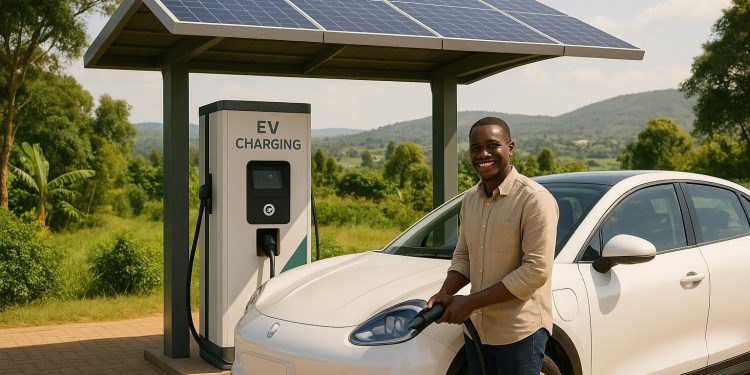Rwanda is making strides in clean transportation by rolling out a nationwide network of solar-powered EV charging stations. Here’s what you need to know:
- EV Growth: From just 19 EVs in 2020 to 512 by 2024, Rwanda is rapidly adopting electric vehicles, including motorcycles, which now dominate 70% of the country’s registered bikes.
- Solar-Powered Network: The plan includes 226 charging sites across all 30 districts, ensuring no vehicle is more than 31 miles from a station.
- Government Support: Tax exemptions, subsidized electricity rates, and rent-free land are attracting private investment to expand infrastructure.
- Economic and Climate Benefits: By 2025, Rwanda is projected to save $15.6 million on fuel imports. EVs powered by solar energy emit less than 0.1 pounds of CO₂ per mile, compared to over 1.0 pounds for gas vehicles.
- Advanced Technology: Charging stations utilize microgrids, battery storage, and Vehicle-to-Grid (V2G) tech for efficient energy use.
This initiative aligns with Rwanda’s Vision 2050, aiming to cut emissions by 38% by 2030 while boosting jobs and economic growth. With solar-powered charging stations, Rwanda is building a cleaner, more accessible transportation future.
The Best EV Experience Centre In Africa | KABISA EV House

Scale of the Solar-Powered EV Charging Station Project
Rwanda is making bold moves to expand its EV charging infrastructure, positioning itself as a leader in East Africa’s transition to electric vehicles. The Ministry of Infrastructure (MININFRA) is spearheading this effort with a master plan aimed at transforming EV operations across the country, covering both bustling cities and remote rural areas. This plan lays the foundation for a nationwide network of charging stations.
Nationwide Rollout and Target Districts
This project is no shot in the dark – it’s backed by careful planning. Using geospatial analysis, 226 potential EV charging sites have been identified across Rwanda, ensuring the network reaches all 30 districts. The goal? To make sure no vehicle is more than 31 miles (50 km) away from a charging station.
This strategic placement directly tackles challenges raised by drivers like Frederick Dusabimana, who notes:
"We understand that EVs are cheaper to charge and maintain compared to fuel-powered vehicles. However, many taxi-moto operators live or travel outside Kigali and may struggle with limited access to charging stations."
The master plan focuses on high-traffic and densely populated areas but doesn’t leave rural districts behind. For instance, in Nyamagabe District, farmers are already seeing the perks of EV adoption. Transport costs for animal feed and harvests have dropped by 100 to 200 Rwandan francs per kilogram as of November 2024.
Currently, Rwanda boasts 24 public vehicle charging stations, 4 direct chargers for motorcycles, and 49 combined charging and battery-swapping facilities.
Public-Private Partnerships in Development
To bring this ambitious network to life, the government is teaming up with private companies. Rwanda has created a business-friendly atmosphere by offering rent-free land, tax exemptions on equipment, and subsidized electricity rates to attract private investment.
One of the key players, Kabisa, plans to establish 38 EV charging stations by the end of 2024, ensuring coverage every 62 miles (100 kilometers) across the country. Srinivas Cheruvu, Managing Director of CFAO Mobility Rwanda, explains the collaborative approach:
"These companies already have the infrastructure, parking, and waiting areas required for charging station installations. We are trying, as distributors, to partner with anyone willing to co-invest and improve the infrastructure."
The strategy includes repurposing existing petrol stations and commercial properties to speed up the rollout. On top of that, the government’s incentive package – featuring zero VAT on EV imports, exemptions on import and excise duties for EV parts, and industrial electricity tariffs for charging – makes it easier for private investors to step in.
While the master plan is still in development and a full rollout timeline hasn’t been announced yet, these public-private partnerships are laying the groundwork for a robust solar-powered EV charging network that could reshape Rwanda’s transportation landscape in the years to come.
Technology Behind the Solar-Powered EV Charging Stations
Rwanda’s solar-powered EV charging stations combine renewable energy with smart grid technology, offering a sustainable solution in a country where only 53% of the population has access to the national grid.
These stations go beyond basic solar panel setups. They utilize Maximum Power Point Tracking (MPPT) systems to optimize solar panel performance. With Rwanda’s solar energy potential averaging 4.5 kWh per m² per day and around 5 peak sun hours, these systems can generate ample energy – even in remote areas.
Solar Energy Integration and Microgrids
The stations seamlessly integrate with Rwanda’s microgrid infrastructure, which can operate both in connection with the main grid and independently. This flexibility is essential for Rwanda’s goal of achieving universal electricity access by 2024. When connected to the main grid, these systems can feed surplus energy back into the network. If the grid goes offline, they continue to function autonomously.
Meshpower has piloted solar-powered EV chargers that demonstrate this dual-mode operation. These setups use battery storage to capture energy during peak sunlight and supply power when demand increases. Charge controllers regulate the electricity flow between solar panels and batteries, preventing overcharging and extending battery life.
A study using HOMER Grid software highlighted the economic benefits of integrating solar PV microgrids with EV charging stations, showing a 139.7% reduction in the levelized cost of electricity (LCOE). Such financial advantages strengthen Rwanda’s commitment to microgrid-based EV infrastructure. Successful examples in rural areas like Kirehe and Nyamasheke Districts further validate this approach.
Rwanda is also exploring Vehicle-to-Grid (V2G) technology, which allows parked EVs to send unused power back to the grid. This two-way energy exchange turns vehicles into mobile energy storage units, providing backup power during outages or when solar generation is low.
Charging Speeds and Infrastructure
In addition to microgrid integration, the network prioritizes efficient charging speeds and reliable infrastructure. Standard charging points are designed to align with solar energy production patterns. The government supports this initiative with subsidized industrial electricity rates of about $0.10 per kilowatt-hour and capped tariffs at 50% of standard industrial rates, making grid-tied charging more appealing to private investors.
Charging stations convert DC power from solar panels or batteries into AC using inverters, with some stations experimenting with wireless power transfer via coils. Control systems oversee power distribution and system performance, offering real-time updates through mobile apps or touchscreens. These systems can also schedule charging to coincide with peak solar output, maximizing the use of clean energy.
"The current incentives to encourage EV uptake will require us to be ready for higher energy demands", says a representative from the Ministry of Infrastructure (MININFRA).
This smart charging technology plays a key role in Rwanda’s efforts to cut greenhouse gas emissions by 63.0% from baseline levels between 2015 and 2030. By improving charging efficiency and syncing with solar generation, these advancements directly support the country’s climate and economic goals.
Impact on EV Adoption and Clean Transportation
Rwanda’s push for a cleaner transportation future is getting a major boost with the development of a new EV charging network. This initiative not only makes life easier for EV drivers but also promotes environmental and economic progress on a national scale. By combining renewable energy sources with strategically located charging stations, the project aims to tackle common barriers to EV adoption, paving the way for a more sustainable and accessible transportation system.
Benefits for EV Drivers
Solar-powered charging stations come with a key advantage: lower charging costs. These stations are strategically placed across various districts, helping to ease the common concern of range anxiety. This means EV drivers can confidently plan longer trips, knowing they’ll have access to reliable charging points. These practical benefits for drivers set the stage for broader positive impacts on the environment and the economy.
Climate and Economic Impacts
The environmental benefits of EVs powered by solar energy are striking. Solar-charged EVs emit less than 0.1 pounds of CO₂ per mile, compared to over 1.0 pounds for gasoline-powered vehicles. Looking ahead, projections suggest that by 2050, more than 150,000 passenger cars in Rwanda will transition to electric vehicles.
On the economic front, the growth of EVs brings significant opportunities. By 2030, road transportation is expected to consume 100 GWh of electricity annually, potentially reaching 500 GWh by 2050 – about 5% of Rwanda’s total energy demand. This growing sector is poised to spark new business opportunities and create jobs across a range of roles, from technical and operational positions to administrative roles in the renewable energy and EV industries.
Solar vs. Grid-Powered Charging Stations Comparison
When comparing solar-powered charging stations to those reliant on the national grid, the advantages of solar become clear:
| Aspect | Solar-Powered Stations | Grid-Powered Stations |
|---|---|---|
| Environmental Impact | Emit less than 0.1 lbs CO₂ per mile | May emit up to 50% more CO₂ than gasoline vehicles when powered by conventional grid energy |
| Energy Supply | Generate renewable energy independently | Depend entirely on the national grid |
This comparison highlights how solar-powered stations are a better choice for achieving long-term sustainability. They not only reduce emissions but also contribute to a more resilient and forward-thinking transportation network.
sbb-itb-7bc66b5
Alignment with Rwanda’s Climate and Economic Goals
Rwanda’s journey toward a cleaner, more resilient future is being shaped by the integration of green technology. The solar-powered EV charging station initiative is a cornerstone of the country’s strategy to achieve both environmental and economic milestones.
Supporting Carbon Neutrality and Renewable Energy Goals
The solar-powered EV charging network is a critical piece of Vision 2050, Rwanda’s ambitious plan to achieve a carbon-neutral economy and foster a healthier environment by mid-century. Achieving this vision demands transformative efforts across all sectors, with transportation playing a pivotal role in cutting emissions.
"Vision 2050 has to be about the future we choose, because we can, and because we deserve it." – Paul Kagame, President of Rwanda
As part of this vision, Rwanda aims to reduce greenhouse gas emissions by 38% – or 4.6 million tons of CO2 – by 2030. Solar-powered EV charging stations help meet these goals by reducing dependence on fossil fuels and increasing renewable energy use. This initiative also aligns with the Green Growth and Climate Resilience Strategy (GGCRS), which prioritizes building a carbon-neutral economy and modernizing transportation systems.
Rwanda’s leadership in sustainable development extends beyond its borders. The country’s updated Nationally Determined Contribution (NDC) climate action plan, supported by an $11 billion investment through 2030, underscores its commitment to global climate goals.
While these initiatives tackle environmental challenges, they also unlock economic opportunities.
Boosting Economic Growth Through Green Jobs
Beyond environmental benefits, this initiative drives economic growth by creating jobs across multiple sectors, including manufacturing, installation, maintenance, and operations. This diversification supports Rwanda’s broader economic goals.
To accelerate the adoption of electric vehicles, the government has introduced incentives that are already showing results. For example, Ampersand operates 32 battery swap stations in Kigali and plans to produce 18,000 batteries for its fleet by 2025. Similarly, electric bus companies like IZI Electric and Basigo, backed by funding from the Rwanda Green Fund, are expanding their fleets to 100 buses.
Electric motorcycle drivers also see financial advantages, with annual savings of up to $840 – boosting take-home pay by as much as 45%. These savings not only improve individual livelihoods but also align with Rwanda’s goal of achieving upper middle-income status by 2035 and high-income status by 2050.
The solar-powered charging network is expected to generate jobs across the value chain, from technical roles in renewable energy to positions in fleet management and customer support. These opportunities will build local expertise, strengthen Rwanda’s workforce, and propel the country toward a cleaner and more prosperous future.
Conclusion: Driving Rwanda Toward a Clean Future
Rwanda’s move toward solar-powered EV charging stations is more than just an infrastructure upgrade – it’s a step toward a greener and more prosperous future. This initiative addresses environmental concerns while unlocking economic opportunities, showcasing how clean energy can fuel progress.
The numbers tell the story. Road transport accounts for 13% of Rwanda’s national emissions, but Ampersand’s 2,750 electric motorcycles are already cutting 7,000 tonnes of emissions every year. Expanding this network is crucial to achieving the country’s goal of a 38% emissions reduction by 2030.
The economic impact is just as impressive. Electric motorcycle drivers are boosting their income by 45%, saving about $840 annually on fuel and maintenance. These savings don’t just stay in their pockets – they’re being funneled into education, home improvements, and small businesses, creating a ripple effect that strengthens local communities. This highlights the broader value of renewable infrastructure investments.
What’s more, this growing network of solar-powered stations does more than support EVs – it also strengthens the energy grid, ensuring a reliable and renewable power supply.
Rwanda’s Vision 2050 builds on these successes, emphasizing collaboration among stakeholders to sustain momentum. Companies like Ampersand are already stepping up, with plans to produce 18,000 batteries by 2025 and expand their battery swap network.
For Rwandans thinking about switching to electric vehicles, the increasing availability of solar-powered charging stations removes a significant hurdle. As more stations come online, EVs are becoming a practical and smart choice – both environmentally and economically – paving the way for a cleaner, brighter future.
FAQs
How will Rwanda’s solar-powered EV charging stations help reduce emissions by 38% by 2030?
Rwanda’s Push for Solar-Powered EV Charging Stations
Rwanda is making strides toward cutting its greenhouse gas emissions by 38% by 2030, and one of its key moves is investing in solar-powered EV charging stations. These stations not only make it easier for drivers to embrace electric vehicles (EVs) but also provide an environmentally friendly alternative to traditional charging methods. By reducing dependency on fossil fuels, they offer a cleaner, more sustainable solution for the nation’s growing transportation needs.
This initiative is part of Rwanda’s larger e-mobility strategy, which targets converting 20% of vehicles to electric power by 2030. As more drivers switch to EVs, the country can take a big step toward lowering emissions from transportation. This effort fits into Rwanda’s bigger picture – achieving carbon neutrality by 2050 and building an economy that prioritizes sustainability and green innovation.
What is the Rwandan government doing to attract private investment in solar-powered EV charging stations?
The Rwandan government is rolling out a variety of incentives to attract private investment in solar-powered EV charging networks. Among these is the provision of rent-free land on government-owned properties, specifically for building charging stations. They’re also weaving EV charging infrastructure into urban development plans, ensuring it becomes a key part of the country’s growth.
On top of that, Rwanda has set an ambitious target: establishing 200–300 solar-powered EV charging stations by 2025. This plan extends to off-grid charging options and emphasizes the use of renewable energy, underscoring Rwanda’s dedication to eco-friendly transportation and sustainable energy solutions.
How do microgrids and Vehicle-to-Grid (V2G) technology make Rwanda’s solar-powered EV charging stations more efficient?
Microgrids and Vehicle-to-Grid (V2G) technology are game-changers for Rwanda’s solar-powered EV charging stations. These systems allow energy to flow in both directions, meaning electric vehicles can not only charge but also return unused energy to the grid. This two-way exchange helps stabilize the energy system and reduces dependence on external power sources.
By using this approach, energy usage becomes more efficient, supply and demand are better balanced during peak times, and the overall energy system becomes more reliable. Integrating these technologies makes Rwanda’s charging stations more affordable to operate and more resilient, aligning perfectly with the nation’s push for renewable energy and eco-friendly transportation.
Related posts
- Rwanda EV Charging Gaps: Key Challenges
- Rwanda’s ICE Vehicles: Carbon Emissions Impact
- Rwanda’s Plan for 20% Electric Buses by 2030
- Is Rwanda Ready for Electric Vehicles?





